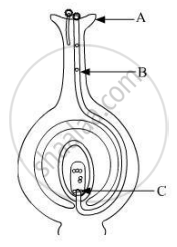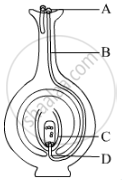Advertisements
Advertisements
Question
__________ is present in unisexual flower.
Options
Both androecium and gynoecium
Only androecium
Only gynoecium
Androecium or gynoecium
Solution
Androecium or gynoecium is present in unisexual flower.
APPEARS IN
RELATED QUESTIONS
Name the parts A, B and C shown in the diagram and write their functions.

Name the parts labelled as A, B, C and D in the diagram given below:

Give one example of a unisexual flower.
Explain what you understand by sexual reproduction.
How does the process of fertilisation take place in flowers?
Mature ovary forms the ______.
Fill in the following blank with suitable word :
Ovules contain ......... gametes of a plant.
Fill in the following blank with suitable word :
The ovule becomes a .......... after fertilisation.
Give some examples of different modes of fertilisation in nature?
What type of plants reproduce by sexual reproduction method?
What is seed? What are the parts of a seed? Explain with the help of a labelled diagram.
The flask-shaped organ A at the centre of a flower is surrounded by a number of little stalks B having swollen tops which lie just inside the ring of petals.
(a) Name A. What are the various parts of A?
(b) Which part of A contains gametes?
(c) Name B. What is the swollen top of B known as?
(d) What does the swollen top of b contain?
(e) Out of A and B, which one is (i) male part, and (ii) female part of the flower?
When an insect sits on the flower of a plant then some particles A present in the top of little stalks in the flower attach to its body hair. When this insect now sits on the flower of another similar plant, then particles A attached to the hair of insect are put on the top of a flask-shaped organ at the centre of flower. The particle A grows a long tube b from the top of flask-shaped organ through which C moves down and reaches the bottom part of flask-shaped organ. Here C fuses with the nucleus of d contained in structure E. the fusion of C and D forms a new cell f which grows and develops into a seed of the plant.
(a) What are particles A? What is the process of transferring A from one flower to another flower of similar plant by the insect known as?
(b) What is the name of tube B?
(c) What is C which moves down through the tube B?
(d) Name D and E.
(e) What is F?
In a bisexual flower, inspite of the young stamens being removed artificially, the flower produces fruit. Explain.
Multiple choice question. Tick (✓) the correct choice:
Unisexual flowers are found in
- mulberry
- mustard
- pea
- sunflower
Mention the function of Flower.
In the figure, the parts marked A, B and C are sequentially:

(A) Plumule, Radicle and Cotyledon
(B) Radicle, Plumule and Cotyledon
(C) Plumule, Cotyledon and Radicle
(D) Radicle, Cotyledon and Plumule
Explain sexual reproduction in plants.
Fill in the blank by selecting suitable word:
Transfer of pollen grains from the anther to the stigma is known as______________.
What is pollination? Mention its types.
What is meant by pollination?
Pollen grains are formed by _________ division in locules of anthers.
The essential parts of a flower are ______.
Where does the endothecium layer of anther lobes is present?
In which of the following manner the arrangement of megaspores in a tetrad is observed in angiosperms?
Which type of development is observed in male gametophytes of plants?
Flowers showing ornithophily show few characteristic like ______.
What would be the number of chromosomes in the cells of the aleurone layer in a plant species with 8 chromosomes in its synergids?
The process of release of eggs from the ovary is called ______
In human beings, fertilization occurs in the ______
Which out of the following processes does not lead to the formation of clones.
Which among the following statements are true for sexual reproduction in flowering plants?
- It requires two types of gametes
- Fertilisation is a compulsory event
- It always results in formation of zygote
- Offspring formed are clones
Sketch and label the essential and accessory whorls of flower.
Give any two examples of agents of pollination.
In a plant flower the female whorl is ______.
What are the agents for pollination?
- Assertion: Primary endosperm nucleus is diploid.
- Reason: It is the product of double fertilisation.
